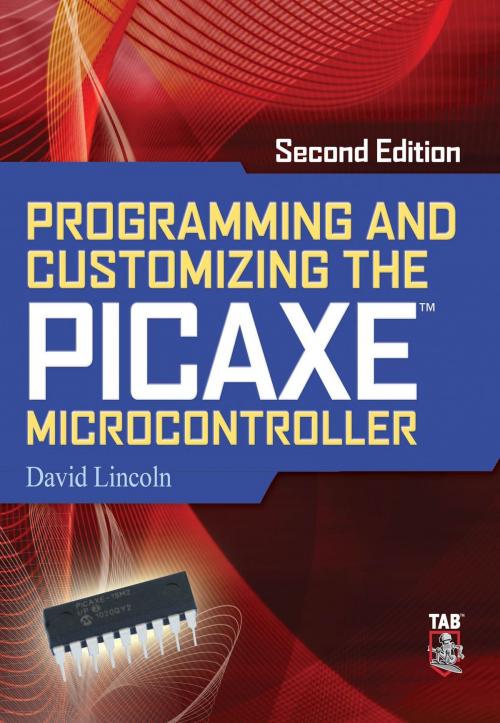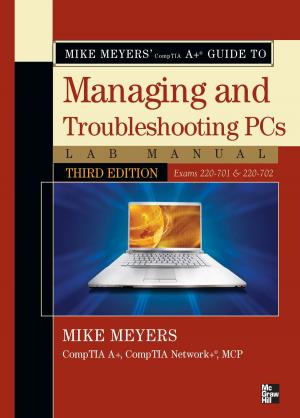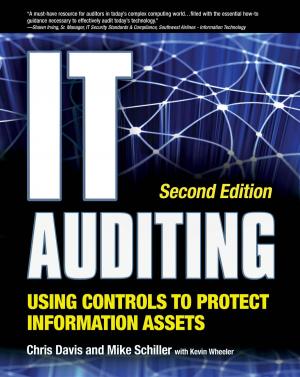Programming and Customizing the PICAXE Microcontroller 2/E
Nonfiction, Science & Nature, Technology, Electronics, Circuits| Author: | David Lincoln | ISBN: | 9780071745550 |
| Publisher: | McGraw-Hill Companies,Inc. | Publication: | November 15, 2010 |
| Imprint: | McGraw-Hill/TAB Electronics | Language: | English |
| Author: | David Lincoln |
| ISBN: | 9780071745550 |
| Publisher: | McGraw-Hill Companies,Inc. |
| Publication: | November 15, 2010 |
| Imprint: | McGraw-Hill/TAB Electronics |
| Language: | English |
Fully updated to cover the latest PICAXE hardware and software upgrades and capabilities Since Programming and Customizing the PICAXE Microcontroller was first published, the PICAXE range has grown significantly, and new, upgraded hardware and software have been released. Mac and UNIX support are now available, as are additional analogue inputs, low-voltage operation, clock frequencies up to 64 MHz, and more variables. Input/output pins are now software configurable, hardware interrupts have been introduced, and programs up to 32,000 lines of code are now possible. This practical guide covers all of these upgrades and innovations. The new PICAXE system has many features of a high-end commercial microcontroller development system without the complexity and expense. In this book, you'll quickly learn how to build microcontroller systems using principles that can be applied to high-end development systems. This updated edition shows you how to maximize the power of the PICAXE microcontroller. Programming and Customizing the PICAXE Microcontroller, Second Edition : Covers support for Windows, Mac, and UNIX platforms Includes flowchart and circuit-based simulation Explains enhanced compiler features that make writing code easier, operation faster, and transition to other languages easier Highlights improved simulation and debugging abilities Covers upgraded serial communications commands that make use of hardware I/O where possible, allowing you to write code that is similar to commercial applications Includes dozens of projects that demonstrate new features Is linked to a website with additional projects and third-party software Complete coverage of the PICAXE microcontroller: Microcontroller Hardware; Packaging; Internals; Logic Levels; Handling Precautions; PICAXE Architecture; Interfacing and Input Output Techniques; Voltage Range; Overvoltage Protection; Current Limiting - Internal/External; Fixed Pin Assignment; Programmable Pin Assignment; Assigning Pins as Input/Output; Port Addressing; Digital Interfacing; Analog Interfacing; Serial Interfacing; Software Development; Creating Programs using Code; Creating Programs using Flowchart; Programming Software; Programming; What is a Program; Writing Code; Data; Commands; Labels; Comments; Reserved Words; Assigning Values to Variables; Symbols & Meaningful Names; Setting Output Ports; Reading Input Ports; Advanced Programming; Code Structures; Program Flow; Loops; Pointers; Subroutines; Pausing and Stopping Execution; Interrupts; Program Testing and Debugging; Power Saving; PICAXE Arithmetic; Experiments; Construction; Basic; Intermediate; Advanced; Appendices; Circuit Symbols; ASCII Character Set; Pinout Diagrams; Introduction to Electronic Theory
Fully updated to cover the latest PICAXE hardware and software upgrades and capabilities Since Programming and Customizing the PICAXE Microcontroller was first published, the PICAXE range has grown significantly, and new, upgraded hardware and software have been released. Mac and UNIX support are now available, as are additional analogue inputs, low-voltage operation, clock frequencies up to 64 MHz, and more variables. Input/output pins are now software configurable, hardware interrupts have been introduced, and programs up to 32,000 lines of code are now possible. This practical guide covers all of these upgrades and innovations. The new PICAXE system has many features of a high-end commercial microcontroller development system without the complexity and expense. In this book, you'll quickly learn how to build microcontroller systems using principles that can be applied to high-end development systems. This updated edition shows you how to maximize the power of the PICAXE microcontroller. Programming and Customizing the PICAXE Microcontroller, Second Edition : Covers support for Windows, Mac, and UNIX platforms Includes flowchart and circuit-based simulation Explains enhanced compiler features that make writing code easier, operation faster, and transition to other languages easier Highlights improved simulation and debugging abilities Covers upgraded serial communications commands that make use of hardware I/O where possible, allowing you to write code that is similar to commercial applications Includes dozens of projects that demonstrate new features Is linked to a website with additional projects and third-party software Complete coverage of the PICAXE microcontroller: Microcontroller Hardware; Packaging; Internals; Logic Levels; Handling Precautions; PICAXE Architecture; Interfacing and Input Output Techniques; Voltage Range; Overvoltage Protection; Current Limiting - Internal/External; Fixed Pin Assignment; Programmable Pin Assignment; Assigning Pins as Input/Output; Port Addressing; Digital Interfacing; Analog Interfacing; Serial Interfacing; Software Development; Creating Programs using Code; Creating Programs using Flowchart; Programming Software; Programming; What is a Program; Writing Code; Data; Commands; Labels; Comments; Reserved Words; Assigning Values to Variables; Symbols & Meaningful Names; Setting Output Ports; Reading Input Ports; Advanced Programming; Code Structures; Program Flow; Loops; Pointers; Subroutines; Pausing and Stopping Execution; Interrupts; Program Testing and Debugging; Power Saving; PICAXE Arithmetic; Experiments; Construction; Basic; Intermediate; Advanced; Appendices; Circuit Symbols; ASCII Character Set; Pinout Diagrams; Introduction to Electronic Theory















